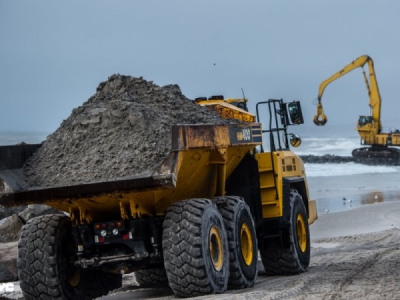
Posted on November 3, 2020
Construction on six-miles of storm surge flood protection along the Queens waterfront began on Thursday. The work is starting eight years after Hurricane Sandy battered waterfront communities in the Rockaways and across New York City.
“It’s a really, really exciting milestone to now see this work move forward, especially for a community that was so devastated by Hurricane Sandy,” Jainey Bavishi, the director of the Mayor’s Office of Resiliency told Gothamist. “We’re now working to transform the waterfront, and build climate protection into it. And this is just one of many examples that we’ll see come online.”
The Rockaways were hit hard by the 2012 storm. More than 1,000 structures were destroyed, and 10 feet of storm surge flooded the area. Queens residents lived for months without heat and with mold in their homes from the water damage.
The first phase of the Rockaways — Atlantic Shorefront project includes building out or restoring nearly 20 stone groin structures—similar to rock jetties—into the ocean to keep sand from washing away on the beach.
Then, a network of dunes built after the 2012 storm will be reinforced with stone and steel to make them two-to-four feet higher. Then more sand will be added to the beach.
“All these elements will provide various layers of protection for the Rockaway peninsula,” Bavishi said.
The federally-funded, $336 million project, runs from Far Rockaway to Riis Beach, and is supposed to be completed in 2024.
The stone structures built out into the Atlantic Ocean are intended to protect the beach from erosion, which in recent years has forced stretches of the beach to close. After beaches were rebuilt post-Sandy in 2014, local officials had criticized the city for failing to implement longterm protective measures that would keep the sand from washing away. Construction was expected to begin a year ago.
Now, those protective groins are finally being built—eight years after Sandy and ominously during rainy downpours from Tropical Storm Zeta, the 27th storm in an unusually busy storm season. Hurricanes and tropical cyclones are expected to intensify from climate change as the world gets warmer.
The Mayor’s Office released a video explaining how the project works on Thursday:
The de Blasio administration said that efforts will be taken to minimize the impact to beaches during the summer months between Beach 90th and Beach 105th, and that they will hold monthly stakeholders meetings will work with local residents. Work will also be paused between late March and September, from Beach 6th and Beach 85th, to protect endangered plant and bird species, such as the seabeach amaranth, piping plovers, and red knots. A detailed timeline was not immediately available.
In the wake of Sandy, the city has worked to create plans various measures of flood protections along the waterfront, while continuing to allow development in low-lying areas. But some scientists say that managed retreat—the practice of buying out homeowners in low-lying areas to turn the land into a natural storm barrier —is critical for the longterm sustainability of the city’s coastal neighborhoods as sea levels rise.
Asked about why urgent climate protection projects like these take so long, Bavishi said, “These are incredibly complex projects.”
“We’re doing unprecedented, unprecedented work here. These kinds of projects have never been implemented in a dense urban environment like New York City,” she said.
The city, state’s Department of Environmental Conservation, and U.S. Army Corps of Engineers partnered on the Rockaways — Atlantic Shorefront project. Suffolk County’s H&L Contracting LLC will lead construction on the first portion, under a $114 million contract. Another $237 million plan to build berms and floodwalls in Jamaica Bay is in the design process.
“This crucial resiliency project represents a tremendous effort to reinforce the shoreline and coast,” Colonel Matthew Luzzatto, the Army Corps commander in New York, said in a statement. “Bolstering six miles of resiliency to reduce the devastating impacts of coastal storms saves lives, reduces property and economic damage.”
Source: gothamist





